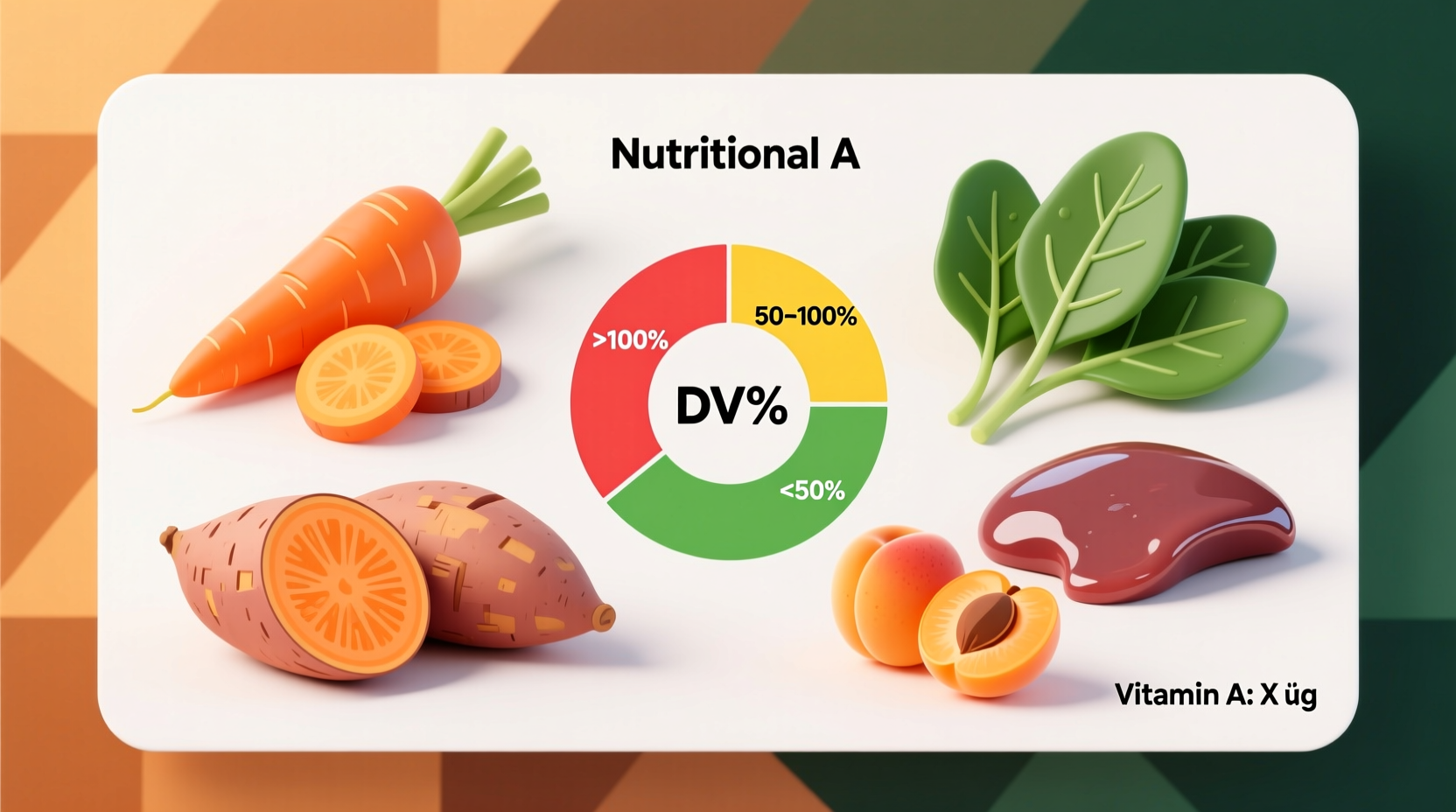The top vitamin A-rich foods include liver (3,460 mcg RAE per 3oz), sweet potatoes (1,403 mcg RAE per medium potato), spinach (573 mcg RAE per 1/2 cup cooked), carrots (459 mcg RAE per 1/2 cup), and cantaloupe (270 mcg RAE per 1/4 melon). Vitamin A exists in two forms: preformed vitamin A (retinol) from animal sources with 70-90% absorption, and provitamin A carotenoids like beta-carotene from plants with 30-50% conversion efficiency. Consuming these vitamin A power foods supports optimal vision, immune function, and skin health when incorporated into balanced meals.
Why Vitamin A Matters for Your Health
Vitamin A isn't just for night vision—this essential nutrient regulates immune responses, maintains skin barrier integrity, and supports cellular growth. According to the National Institutes of Health, approximately 25% of Americans don't meet daily vitamin A requirements, potentially impacting immune resilience. The Recommended Dietary Allowance (RDA) is 900 mcg RAE for men and 700 mcg RAE for women, but individual needs vary based on age, health status, and dietary patterns.
Understanding Vitamin A Forms: Retinol vs. Beta-Carotene
Not all vitamin A is created equal. Animal-based foods provide preformed vitamin A (retinol, retinal, retinoic acid) that your body uses directly. Plant foods offer provitamin A carotenoids, primarily beta-carotene, which your body converts to active vitamin A. This conversion process explains why you need to eat more plant sources to match animal-based vitamin A intake. For example, 1 mcg of retinol equals 12 mcg of beta-carotene from food sources.

Top 10 Animal-Based Vitamin A Powerhouses
Animal sources deliver vitamin A in its most bioavailable form. These foods provide retinol that your body can use immediately without conversion:
| Food (Serving Size) | Vitamin A (mcg RAE) | Daily Value % | Absorption Rate |
|---|---|---|---|
| Liver (3 oz beef) | 3,460 | 384% | 70-90% |
| Fish oil (1 tbsp) | 1,350 | 150% | 85-95% |
| Egg yolk (1 large) | 75 | 8% | 60-70% |
| Whole milk (1 cup) | 149 | 17% | 50-60% |
| Cheddar cheese (1 oz) | 92 | 10% | 40-50% |
Source: USDA FoodData Central, 2023 release. Note that liver consumption should be limited to 1-2 servings weekly due to extremely high vitamin A content, which can accumulate to toxic levels with excessive intake.
Top 10 Plant-Based Vitamin A Sources
Plant foods provide beta-carotene and other carotenoids that convert to vitamin A. These vitamin A rich foods for immune system support require dietary fat for optimal absorption:
- Sweet potato (1 medium, baked): 1,403 mcg RAE (156% DV) - Contains 400% more beta-carotene than carrots
- Spinach (1/2 cup cooked): 573 mcg RAE (64% DV) - Best absorbed when lightly cooked
- Carrots (1/2 cup cooked): 459 mcg RAE (51% DV) - Raw carrots provide only 25% of this amount
- Cantaloupe (1/4 melon): 270 mcg RAE (30% DV) - Peak absorption when eaten with healthy fats
- Red bell peppers (1/2 cup raw): 150 mcg RAE (17% DV) - Vitamin C enhances carotenoid absorption
- Mango (1 cup): 112 mcg RAE (12% DV) - Best consumed when fully ripe
- Papaya (1 cup): 100 mcg RAE (11% DV) - Contains digestive enzymes that aid nutrient uptake
- Broccoli (1/2 cup cooked): 60 mcg RAE (7% DV) - Steaming preserves 90% of carotenoids
- Tomato juice (1 cup): 50 mcg RAE (6% DV) - Lycopene content increases with cooking
- Green leaf lettuce (1 cup): 40 mcg RAE (4% DV) - Choose darker varieties for higher nutrient density
Maximizing Vitamin A Absorption: Practical Strategies
Simply eating vitamin A foods isn't enough—your body needs the right conditions to absorb this fat-soluble nutrient. Research from the American Journal of Clinical Nutrition shows that adding 3-5 grams of dietary fat increases carotenoid absorption by 100-150%. Try these evidence-based techniques:
- Pair plant-based vitamin A sources with healthy fats like olive oil, avocado, or nuts
- Cook vegetables lightly—steaming preserves nutrients better than boiling
- Combine vitamin C-rich foods (citrus, bell peppers) with carotenoid sources to enhance conversion
- Avoid excessive alcohol consumption, which impairs vitamin A metabolism
- Include zinc-rich foods (pumpkin seeds, lentils) as zinc is required for vitamin A transport
Special Considerations for Vitamin A Intake
Vitamin A requirements and safety vary significantly across populations. The World Health Organization identifies specific considerations:
- Pregnant women should avoid excessive preformed vitamin A (over 3,000 mcg RAE daily) due to potential birth defect risks, but plant-based carotenoids are safe
- Individuals with cystic fibrosis or Crohn's disease often require vitamin A supplementation due to malabsorption issues
- Vegans need to consume 1.5-2 times more plant-based vitamin A sources to meet requirements
- Smokers should prioritize food sources over supplements, as beta-carotene supplements may increase lung cancer risk in this population
Building Vitamin A-Rich Meals: Simple Daily Strategies
Integrating vitamin A foods into your diet doesn't require dramatic changes. These practical approaches make it effortless:
- Morning: Add spinach to smoothies (1 cup provides 145 mcg RAE) with almond butter for fat
- Lunch: Prepare sweet potato salad with olive oil dressing and pumpkin seeds
- Snack: Enjoy carrot sticks with hummus (the tahini provides necessary fat)
- Dinner: Serve grilled salmon with roasted red bell peppers and steamed broccoli
- Weekly: Include one liver-based meal (beef liver pâté with whole grain toast)
When Food Sources Aren't Enough: Supplementation Guidance
While whole foods should be your primary vitamin A source, certain situations may warrant supplementation under medical supervision. The National Institutes of Health notes that vitamin A deficiency affects approximately 127 million preschool children worldwide. If considering supplements:
- Choose supplements providing vitamin A as mixed carotenoids for plant-based options
- Avoid exceeding 10,000 IU (3,000 mcg RAE) daily from supplements without medical supervision
- Look for supplements containing both vitamin A and vitamin E, which work synergistically
- Store supplements away from light and heat to prevent nutrient degradation











 浙公网安备
33010002000092号
浙公网安备
33010002000092号 浙B2-20120091-4
浙B2-20120091-4